Frederick Ruple facts for kids
Quick facts for kids
Frederick Ruple
|
|
|---|---|

Ruple in 1932
|
|
| Born | September 19, 1871 Switzerland
|
| Died | May 22, 1938 (aged 66) Tulsa, Oklahoma, U.S.
|
| Nationality | Swiss-American |
| Education | Photographer Carl Emil Gassler (1887-1891) Basel Switzerland |
| Known for | Painting, portrait, murals, battle scenes, nature and Indians. |
|
Notable work
|
"The Spirit of 89" "Battle of Paris" "Tribal Camp Fire" |
Frederick Ruple (born September 19, 1871 – died May 23, 1938) was a talented Swiss-American painter from the 1900s. He was best known for his amazing portraits. Ruple also painted exciting Civil War battle scenes and large murals. He spent time in Arkansas and Oklahoma, where he studied American Indians and the early settlements in the Midwest. The famous Oklahoma Land Run of 1889 inspired Ruple to create his most well-known painting, "The Spirit of '89".
Frederick Ruple often took on special painting jobs. Builders and decorators hired him to create murals and designs for public buildings. His work became some of the most important art in America at that time.
Contents
Early Life and Art Training
Frederick Ruple was born on September 19, 1871, in a town called Unterhallau in Schaffhausen, Switzerland. His parents were Hermann Rupli and Barbara Neukomm.
When Frederick was 14, his mother moved to Basel, Switzerland. Frederick started learning how to make artificial limbs. However, he also went to general school. When he was 16, he began training as a photographer with Emil Gassler. Gassler's studio offered "Photographs in all sizes, portraits in oil," which likely sparked Frederick's interest in painting.
In 1891, at age 19, Ruple and his mother moved to America. Around this time, his last name changed from Rupli to Ruple.
They first lived in Cincinnati. There, an art dealer saw Frederick's drawings. The dealer ordered a colored copy of a photograph. This was the first piece of art he sold in America.
Later, Ruple moved to Little Rock, Arkansas. He became a student of Mrs. James P. Eagle, whose husband was the state's governor. This is when Ruple truly began his career painting portraits. Important people like Governor Eagle and General Forest sat for him.
Family Life
After three years in America, Frederick married Almira C. King on December 25, 1894, in Belmont, Ohio. Almira was born in June 1873.
By 1900, Frederick and Almira lived in Lonoke, Arkansas. They had a three-year-old son named Frederick D. Ruple. He was born in Ohio.
By 1910, the family had grown. Frederick and Almira had two sons and a daughter. Their children were Frederick D., George W., and Almira C. They lived in Ruddell township, Arkansas.
In 1920, the family was renting a home in Batesville, Arkansas. Sadly, Almira (also known as Mollie) died on March 5, 1925.
By 1930, Frederick had married Mildred Ruple. They lived in Fayetteville, Arkansas with their two young children, Robert and Mary Louise. Frederick's older children, Fred and Myra, also lived with them.
Frederick had his art studio in Fayetteville. He also ran a private painting school there. Many of his paintings were displayed in people's homes. Sadly, his son George died from tuberculosis in 1934.
In his later years, Frederick Ruple lived in Tulsa, Oklahoma. He faced health problems and passed away from a heart attack on May 23, 1938, at his home.
Famous Artworks
"The Spirit of '89"
This painting shows the very beginning of the Oklahoma land rush in 1889. The main person in the painting is Major Gordon W. Lillie, also known as Pawnee Bill. He was a famous scout. You can see him in his scout uniform, leading the charge. The painting is very large, measuring 9 feet by 12 feet with its frame.
A businessman named Lew Wentz bought "The Spirit of '89." He gave it to Ponca City, which then gave it to the Oklahoma Historical Society. Today, you can see this important painting hanging in their building.
Civil War Paintings
Ruple created several paintings about the American Civil War. These artworks show battle scenes involving the Confederates. For example, his painting "Battle of Paris 1862" shows a small fight near Forrest Heights on March 11, 1862.
Another painting, "General Nathan Bedford Forrest," shows the Confederate war hero. He is on his horse, King Phillip, with his sword drawn. He is surrounded by Union soldiers during the Battle at Bogler's Creek, Alabama.
Ruple also painted "Edmund Winchester Rucker." This work shows the Battle of Brice's Crossroads, which happened on June 10, 1864. In this painting, General Forrest is again on King Phillip, but his sword is put away, and he is with his men.
Other Important Works
The painting "Tribal Camp Fire" is displayed in the John Burroughs school building in Tulsa, Oklahoma.
While he lived in Fayetteville, Ruple painted portraits of Dr. H. D. Wood and Major D. R. Davidson.
Portraits of Famous People
Most of Ruple's fame came from painting portraits of well-known people in Arkansas and Oklahoma. These included Confederate Generals and important politicians. Some of his subjects were:
- Former United States Senator Robert L. Owen of Oklahoma.
- Supreme Court Judge U.M. Rose of Little Rock, Arkansas.
- The father of Senator Joe Robinson.
- J.S. Parks and E. B. Kinsworthy, who was a former Attorney-General of Arkansas.
- Mrs. Walter Ferguson, a newspaper writer.
- Her husband, Arkansas Senator Caraway.
- Judge Thomas of Muskogee.
- William Busy of McAlester.
Many of his portraits can still be found in Batesville, Fayetteville, and Fort Smith, Arkansas.
Murals in Public Buildings
Paul Heerwagen was an interior decorator who hired Frederick Ruple for big projects. Ruple painted four murals in the Capital Building in Little Rock. He also created murals for the Strand Theater in Shreveport, Louisiana. Additionally, he painted murals for the Sahara Shrine Temple in Pine Bluff.
Images for kids




